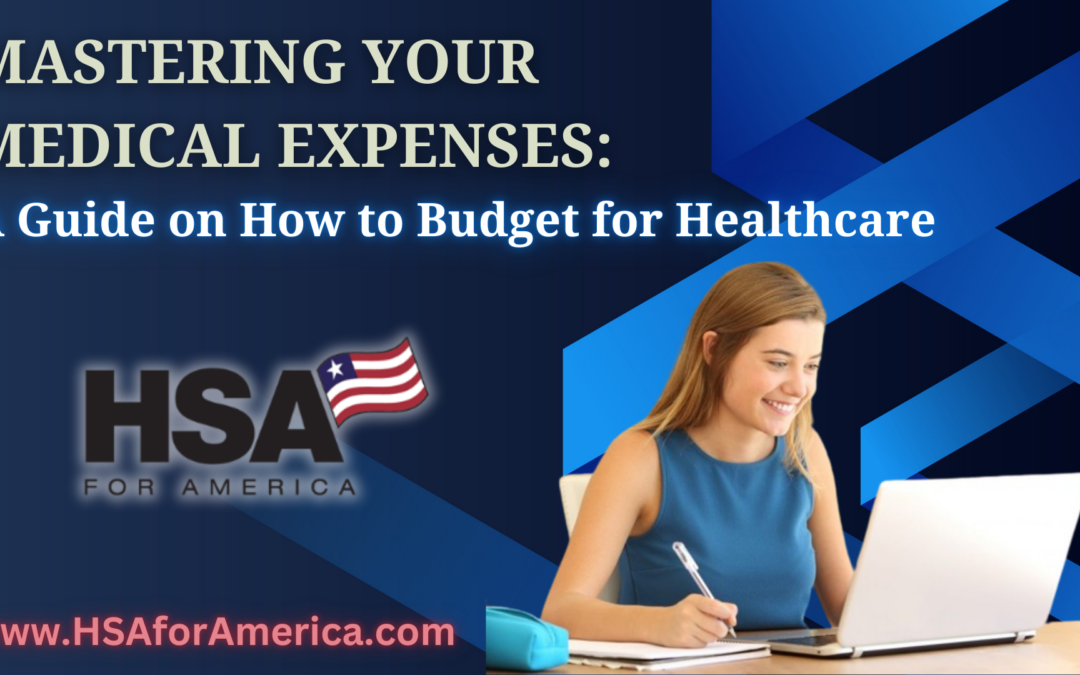With Health Insurance Open Enrollment beginning on October 15th every year, now is the perfect time to sit down and come up with a budget for healthcare.

However, choosing a health insurance plan isn’t the only factor that comes into play when budgeting for healthcare.
This HSA for America expert guide’ll explain how to budget for healthcare and explore several high-value alternatives, like medical cost-sharing plans, that can lower your monthly premiums.
2024 Guide: How to Budget for Healthcare: Key Takeaways
- Your ongoing health is the most important factor to consider when creating a healthcare budget. Choosing the plan with the lowest premium can be tempting, but if you ignore your actual health needs, you are increasing your financial risk.
- Health insurance has three different cost brackets to consider: Monthly premiums, out-of-pocket expenses (copays and prescriptions), and the plan deductible.
- A house-wide emergency plan should include potential medical costs. Ideally, you should have enough money in your emergency fund to cover 3 to 6 months of expenses. In addition, you should be able to cover your deductible.
- Health Savings Accounts (HSAs) can act as an emergency fund, as well as a long-term investment vehicle. If you have an HSA, make the maximum contribution every year to maximize your returns.
- Health Insurance is not the only option when it comes to healthcare. Across the country, Health Care Sharing Ministries (HCSMs) are offering low-cost medical sharing programs. These are particularly well-suited to people who don’t qualify for a subsidy, or who don’t expect to use their coverage that much
Step 1: Know Your Healthcare Cost Key Terms
Health insurance plans in the U.S. are mostly standardized when it comes to key terminology. Here are the terms and definitions you’ll need to create your healthcare budget.
The Four Most Common Healthcare Expenses:
- Premium: The monthly payment you make for your health insurance plan.
- Deductible: The total cost you have to pay for healthcare services before your insurance plan “kicks in”.
- Coinsurance: A per-service fixed percentage that you pay for medical bills
- Copayment: A flat-rate fee that you pay when you visit the doctor or another medical professional.
Note: Not all health insurance plans have both coinsurance and copays. Depending on the type of care you need, your plan could require one or the other, or both. Be sure to read your Summary of Benefits and Coverage before you commit to a new plan.
HealthShare Terms
Health Sharing Plans are low-cost medical sharing programs, where the community comes together to pay member medical bills.
These plans are not insurance. Because of this, HCSMs do not use the same terms and definitions as health insurance plans. In addition, most HCSMs don’t even use the same terms as each other.
Here are the healthshare definitions you should know if you’re thinking about switching:
- Member Contribution / Share / Portion: This is the monthly payment that you will make towards your sharing program.
- Annual Household Portion (AHP) / Initial Unshared Amount (IUA): Similar to a health insurance deductible, this is the dollar amount that the member must pay for before the rest of the bill is eligible for cost sharing.
- Annual or Lifetime Sharing Limit: Some health sharing plans come with annual or lifetime limits on how much cost sharing a member can get. These HCSMs offer multiple options when it comes to annual and lifetime limits. Many healthshare plans don’t have sharing limits at all.
Step 2: Calculate Your Annual Cost of Healthcare
To make the most of your health insurance plan, it’s essential to estimate your annual healthcare costs. Here’s a breakdown:
1. Monthly Premiums: If you already have health insurance, you know your monthly premium. For those planning to get insurance in 2024, you can get an estimate here. Don’t forget, you might qualify for a subsidy to reduce your costs. Multiply your monthly premium by 12 to get your annual cost.
2. Copays: Estimate the annual cost of copays for doctor visits. Typical costs are around $20 for primary care visits, $50 for specialists, and up to $300 for emergency room visits. Planning for about $300 in copays annually can cover emergencies and may leave you with extra funds by year’s end.
3. Prescription Drugs: Review any ongoing prescriptions for you or your family members. You can compare prices at different pharmacies since costs can vary significantly. Remember, you can use Health Savings Account (HSA) funds to pay for prescriptions.
4. Over-the-Counter Medications and Supplies: Plan for the cost of everyday items like ibuprofen, cough medicine, and first aid supplies. Many of these can also be purchased with tax-free HSA funds.
5. Deductible: If you are both healthy and lucky, then you might make it through the year without having to pay anything towards your deductible. But for emergency services and hospital stays, you may need to meet that deductible right away. This is why it’s a good idea to include your deductible amount into your family’s emergency fund.
By considering these factors, you can better estimate your annual healthcare costs and manage your budget effectively.
To obtain estimated total yearly costs when previewing plans and prices, you begin by providing basic information such as your ZIP code, household size, and income when prompted.
Next, click on “View plans” to see the available options. Once you have accessed the list of plans, you should select the option “Add yearly cost” on any of the plans displayed.
Following this, you will be prompted to specify the level of care you anticipate utilizing in the upcoming year, which can be categorized as low, medium, or high use.
Finally, click on “Save and continue“, after which you will receive the Estimated total yearly costs for each plan available for your consideration.
Step 3: Take a Cost-Reducing Comb to Your Annual Estimate
All of the healthcare costs that were detailed in the last section have one thing in common: they can all be reduced significantly.
The only catch is that they can’t all be reduced at the same time.
Lower Your Premiums
For example, your monthly premium can be reduced simply by switching to a different health insurance plan.
But this may lead to an increase in your deductible.
It’s also possible to lower your monthly costs by switching to a Healthshare program. This is especially true for individuals who don’t qualify for a health insurance subsidy, or who are simply fed up with the insurance companies.
Lower Your Prescription Drug Costs
There are a few reliable ways to immediately reduce the cost of your prescription drugs:
- Use your plan’s Rx discount program, if it has one.
- Shop around to different pharmacies for the best prices. Don’t forget to check online pharmacies as well.
- Switch from name-brand to generic.
- Purchase your medications in 90-day supplies instead of 30
Make Your Out-of-Pocket Health Expenses Tax-Free
With a Health Savings Account, it’s possible to set aside tax-free money to use on future health expenses.
This is a specialized savings account that can help your funds grow on a tax-deferred basis, and as long as you only use the funds on qualified expenses, they remain totally tax free.
In order to open and operate an HSA, it’s necessary to be enrolled in a High Deductible Health Plan, or HDHP.
Healthshare members can also take advantage of an HSA, but only certain plans are qualified. MPB Health offers an HSA-qualified healthshare option, but you also need to be enrolled in a Minimum Essential Care (MEC) plan.
Compare Pricing on the Best Insurance Plans Available
Step 4: Maintain a Household Emergency Fund
An emergency fund is a savings account that is set aside to pay for unexpected costs and emergencies.
The rule of thumb for emergency funds is to try and have between 3 and 6 months of living expenses set aside. This can be difficult for anyone, so don’t be afraid to start small.
While HSAs are an excellent tool for emergency health costs, there is a limit to how much you can contribute each year. For this reason, it might be necessary to open an additional savings account for your emergency fund.
Step 5: Work with Your Personal Benefits Manager to Make Any Required Plan Changes
After working through your new 2024 healthcare budget, you might come to the conclusion that you need to re-think your plan strategy.
Whether you need more coverage or a lower premium, your Personal Benefits Manager can help ensure that you’re getting the plan you really need.
Similarly, if you’ve decided to switch to a Health Sharing community, it’s critical that you understand all the options that are available. Not all HCSMs are built alike, and just like insurance, comparing plans can be a daunting task if you’re on your own.
Ready for your no-cost appointment? Click here or call 800-913-0172.
How to Budget for Healthcare: Frequently Asked Questions [FAQ]
Q: How Much Should I Budget for Health Insurance?
When making a healthcare budget, the most important thing is that you’re taking into account the different types of medical expenses. These include:
- Monthly premiums
- Doctor and specialist copays
- Your deductible, if you need care
- Prescription drugs
- Over-the-counter medications (OTC)
It’s a good idea to budget for the full cost of your deductible, as well as a few doctor appointments and an ER copay. Using an emergency fund is a good way to ensure that your healthcare budget is always protected.
Q: What Health Insurance Plan has the Lowest Premium?
Marketplace health insurance plans are largely standardized, which means that all health insurance companies offer plans with low, medium, and high premiums.
The Marketplace offers four main health plan categories for individuals to choose from when comparing plans: Bronze, Silver, Gold, and Platinum. Each of these categories determines how both the individual and the plan will share the costs associated with the care received.
No matter which health insurance company you choose, Bronze-tier plans have the lowest premium. However, they also have higher deductibles than other plans.
Q: Do Health Insurance Plans Cover Prescription Drugs?
Health insurance plans will help pay for the cost of certain, but not all, prescription drugs. All plans have a “formulary”, which is a list of approved medications for that plan.
To find out which prescription costs your plan covers, see your Summary of Benefits and Coverage. This should be easily accessible on your insurer’s website, or through your member portal. Or, you can simply give them a call directly and they’ll tell you what’s covered.
Q: Are Healthshare Plans Cheaper Than Health Insurance?
In general, healthshare plans are more affordable per month than unsubsidized insurance. This is because they are designed to provide protection for large or emergency health costs. They are not required to offer the same level of coverage as marketplace health insurance plans. This is what makes the monthly price lower.
However, this is not a hard and fast rule. If you have ongoing medical needs or you currently use your health insurance plan a lot, then switching to health sharing could actually cost you more money in the long run.
Q: What if I don’t qualify for a health insurance subsidy?
With the passage of the American Rescue Plan in 2021, health insurance subsidies are available to more people than before. But anyone who does not qualify for a health insurance subsidy should look into healthshare programs as a more affordable alternative.
Learn More About How to Budget for Healthcare
Budgeting for healthcare is easy than most people think, and it can go a long way towards creating a healthier and more secure future for you and your family.
If you think that you’re paying too much for your healthcare plan, we can help. Call 800-913-0172 to talk to a Personal Benefits Manager, or click here to schedule a no-cost consultation.
Here are some additional articles on related topics: 2022 HSA Contribution Deadline – What You Need to Know | 9 Savvy Ways to Spend Your Leftover Healthcare Budget | The Top 5 Myths & Misconceptions About Health Insurance | Beware of Surprise “Facility Fees” Medical Bills
Here are some additional pages related to this article: HSA FAQS Health Savings Account Answers | Learn about Healthshare Plans

Hi! I’m Misty Berryman, and I’m one of your Personal Benefits Managers. I like working with HSA for America because we’re creating solutions to healthcare problems. Our focus on money-saving alternatives like HSA plans and health sharing programs, and the variety of health share programs we offer, are what set us apart. Read more about me on my Bio page.



